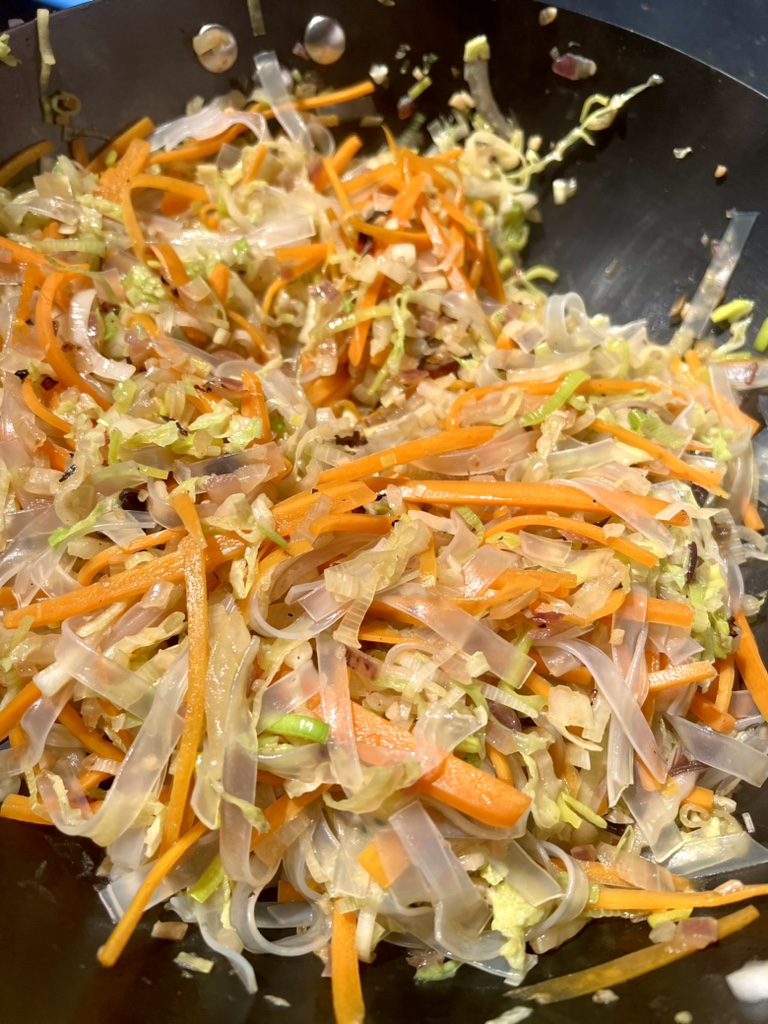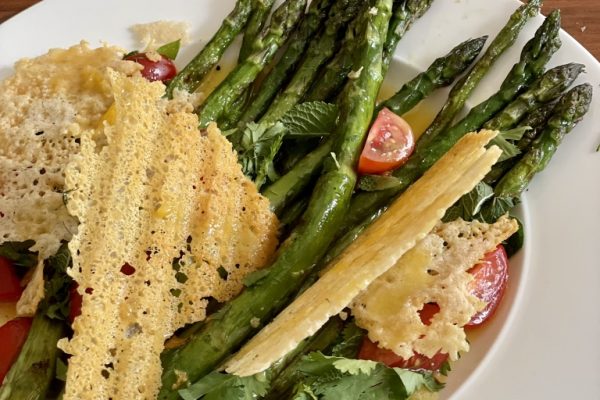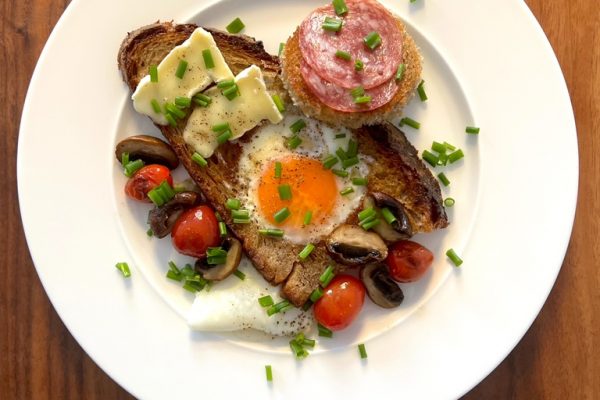In many Asian countries such as China, Thailand, Vietnam, Indonesia, Korea, the Philippines and Japan, a wide variety of fillings are rolled into sheets of dough and sometimes deep-fried.
The deep-fried Chinese version is the world-famous spring roll, which is nowadays mainly popular as an appetiser.
It is of course possible to make the necessary dough yourself, but rolling it out perfectly is quite a challenge. Therefore, you should buy the dough sheets. You can find them refrigerated or frozen in Asian food markets. Be careful, however, not to buy rice paper that is used for – unfried – rolls, which are then called summer rolls or fresh spring rolls.
The dough sheets suitable for deep-frying are square, about 25 cm long and are usually made from wheat flour, but there are also gluten-free versions made from rice flour.
We do without meat and, apart from the dough sheets, we need glass noodles, white or Chinese cabbage, leeks, carrots, onions, ginger, garlic and crunchy sprouts, which for us today are soybean sprouts.

The carrots are peeled and first cut to the desired length (about 5 cm in our case). Then cut a fine slice lengthwise so that you can lay the carrot on the cut surface and process it much more safely, because now it no longer rolls away. Now you cut fine slices lengthwise, which you lay a little on top of each other and in the last step you can easily and quickly cut them into fine strips.

The cabbage is also cut into fine strips. To do this, it is best to detach individual leaves, wash them, lay them on top of each other and roll them up a little. Now slice the roll finely to make perfect strips. Everything else is chopped into small pieces, only the sprouts remain untouched. Simply soak or boil the glass noodles according to the instructions on the packet and then cut them into smaller pieces with scissors, otherwise they will not work well for the filling.

Now fire up the wok, on a high heat. Then heat about 3 tablespoons of neutral oil in it for about 30 seconds and fry the onions.

Then add garlic and ginger until both begin to become fragrant.

Next we add the carrots, which are a rather firm vegetable and need more time.

The next ingredient is cabbage, which quickly looses volume.

Now we add the leeks….

…followed by the glass noodles.

Now season with white pepper, oyster sauce, light soy sauce, sesame oil and salt to taste, if needed at all. If you wish, you can also add a little sugar, but we always like to do without.

Now the heat can be turned off. Stir the sprouts into the filling at the end, as they should remain crunchy.

Get your pastry sheets ready, if they were frozen they will need a good 40 minutes at room temperature to defrost.
Your cooled filling should be moist but not wet. The glass noodles usually absorb the little liquid that is produced during frying perfectly. If there is still liquid on the bottom, you should drain it off.

You need a glue to seal the rolls. You can dissolve flour in water, but we prefer starch. Mix 1 teaspoon of starch in two teaspoons of cold water, this is enough for a lot of spring rolls.
Usually, about 2 tablespoons of filling are rolled into a sheet of dough. You can easily take such rolls in your hand later. However, if you want to make quite large rolls with more filling, as we did today, place a second sheet of dough over the first one for each spring roll.

Since we are working with two sheets at a time, we can now spoon a nice portion of the filling onto the centre of the first sheet.

Now for the rolling: Grasp the dough sheet near the bottom tip with both hands and place it generously over the filling. Now – this is the most important thing – pull the overlapping dough lying on the filling back a little and slightly under the filling so that the dough sheet has contact with the filling all around. A little sensitivity is needed here. You don’t want the filling to be compacted, but you also don’t want it to be loose in the pastry case. Once this is done, you can start rolling.

Now fold the two tips left and right over the roll so that the filling is also well enclosed at the ends of the roll. If we were to use only one sheet of dough, we would have used only about half of the filling and the roll would be much shorter.

Since we are still using a second sheet, we just keep rolling to its centre.

Again, fold the tips left and right to the centre. Shortly before the end of the dough sheet, its upper tip is brushed with glue with your finger.

Now the roll is completely formed and the dough sheet is firmly stuck together after only one minute.

Again in a wok we heat vegetable fat specially suited for high heat. You buy it in solid blocks and not as oil in a bottle. It’s perfect for frying and it solidifies again after cooling, which makes it easy to store: Just before it cools down completely, we pour it into a storage box that goes into the fridge. If you pass it through a sieve to remove any residue, it can easily be used a second and sometimes a third time. The fourth use at the latest should be the end of the story.
You need relatively little fat in a wok because of its shape, but the rolls must be able to float. If you don’t have a wok, you should buy one 😉 . You can also use a pan for frying and a pot for deep-frying. You don’t need a deep fryer in the kitchen at home.
The ideal temperature for spring rolls is 165 – 170 degrees C°. If you don’t have a thermometer for such temperatures, check the heat with a wooden chopstick or the handle of a wooden cooking spoon. If you dip the wood in and air bubbles form around it after about 5 seconds, the temperature is correct. If the bubbles form immediately, it is too hot.
And please: Hot fat is hot. Always work extra carefully when frying and turn the handle of the wok away from you so that you don’t accidentally knock it over. Also use a tool to carefully slide the rolls into the fat so that it doesn’t splatter. Slotted spoons or tongs work very well.

After about 4 – 5 minutes, the dough turns golden.

Carefully remove the rolls from the fat with a slotted spoon or tongs and place them on a cloth or kitchen paper, as they will still release some fat.
You can wait another 10 minutes or even a little longer before eating, as deep-fried food is extremely hot.
The spring roll should be accompanied by a dip. Sweet chilli sauce, which you can buy everywhere, is excellent. You can also make it yourself, of course, but that’s another story.

Enjoy.
And may the taste be with you.
Ingredients (for 20 small rolls or 4 people):
Note: Use just under twice the amount for large rolls, except for the fat.
20 pastry sheets
500 g vegetable fat (for frying)
2 cm ginger
3 cloves of garlic
2 small onions or shallots
Vegetables (for guidance):
300 g cabbage
200 g carrots
1 stick of leek
or other vegetables of your choice, for example snap peas, celery stalks…
100 g glass noodles (dry – Vermicelli are recommended)
Optional:
Shiitake mushrooms, black fungus
(soak dried mushrooms in cold water for 10 – 15 minutes)
For the glue:
1 tsp cornflour or 2 tsp flour
Spices:
White pepper
Salt
2 tbsp oyster sauce
2 tbsp light soy sauce
1 tsp sesame oil





2 thoughts on “Vegetarian Spring Rolls”